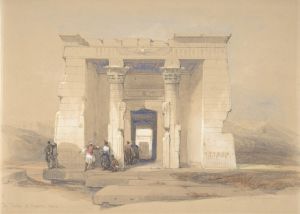
Excavated Temple of Gyrshe [Gerf Hussein], Nubia.
A hand-painted replica of David Roberts’s masterpiece Excavated Temple of Gyrshe [Gerf Hussein], Nubia., meticulously crafted by professional artists to capture the true essence of the original. Each piece is created with museum-quality canvas and rare mineral pigments, carefully painted by experienced artists with delicate brushstrokes and rich, layered colors to perfectly recreate the texture of the original artwork. Unlike machine-printed reproductions, this hand-painted version brings the painting to life, infused with the artist’s emotions and skill in every stroke. Whether for personal collection or home decoration, it instantly elevates the artistic atmosphere of any space.
David Roberts' painting Excavated Temple of Gyrshe [Gerf Hussein], Nubia is a depiction of the ancient rock-cut temple of Gerf Hussein, located in Nubia, a historical region along the Nile River in present-day southern Egypt and northern Sudan. The artwork is part of Roberts' extensive series of lithographs and paintings that document the architecture, landscapes, and monuments of Egypt and the Near East during the 19th century. These works were created during his travels in the region between 1838 and 1839 and were later published as part of his monumental collection, The Holy Land, Syria, Idumea, Arabia, Egypt, and Nubia.
The temple of Gerf Hussein, also known as the "Temple of Ptah," was commissioned by Pharaoh Ramesses II during the 19th Dynasty of ancient Egypt (circa 13th century BCE). It was dedicated to the gods Ptah, Ptah-Tatenen, Hathor, and Ramesses II himself, who was often deified in temples constructed during his reign. The structure was partially free-standing and partially rock-cut, a style characteristic of Nubian temples built during this period. The inner sanctuaries and parts of the temple were carved directly into the sandstone cliffs, while the outer sections were constructed with stone blocks.
Roberts' painting captures the temple as it appeared in the 19th century, prior to its partial submersion due to the construction of the Aswan High Dam in the 20th century. The dam's creation of Lake Nasser led to the flooding of many Nubian monuments, including Gerf Hussein. While some temples, such as Abu Simbel, were relocated to higher ground, Gerf Hussein was not fully saved. Only parts of the temple, such as the free-standing structures, were moved to the Kalabsha area, while the rock-cut sections remain submerged.
David Roberts' works are valued not only for their artistic merit but also for their historical significance. His detailed and accurate depictions of ancient sites provide a visual record of monuments as they appeared before modern restoration efforts, environmental changes, and, in some cases, destruction. The painting of Gerf Hussein is an example of Roberts' ability to combine artistic skill with documentary precision, offering insight into the grandeur of ancient Nubian architecture and the impact of Ramesses II's reign.
Roberts' lithographs were widely acclaimed in Europe and contributed to the growing fascination with Egyptology during the 19th century. His works remain an important resource for historians, archaeologists, and art enthusiasts interested in the cultural heritage of Egypt and Nubia.






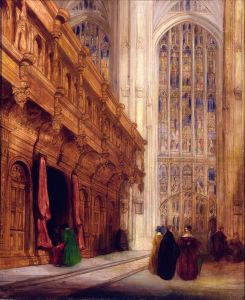
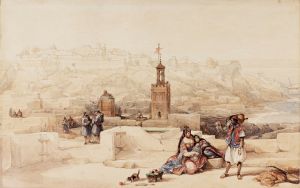
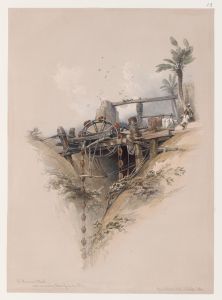
![Excavated temples of Aboosimble [Abû Sunbul], Nubia.](/imgs/217481/s/david-roberts-excavated-temples-of-aboosimble-abu-sunbul-nubia-2ca5e7e8.jpg)
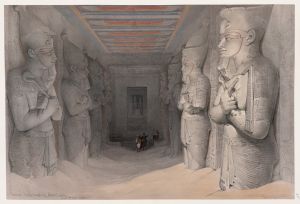

![Pyramids of Geezeh [Giza].](/imgs/217529/s/david-roberts-pyramids-of-geezeh-giza-edcbd9cd.jpg)
![Temple of Dandour [Dendûr], Nubia.](/imgs/217545/s/david-roberts-temple-of-dandour-dendur-nubia-8921547f.jpg)
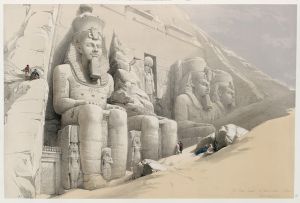
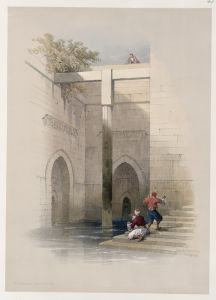
![Group of Nubians, Wady Kardasey [sic] [Qirtâsî].](/imgs/217579/s/david-roberts-group-of-nubians-wady-kardasey-sic-qirtasi-c64109d2.jpg)
